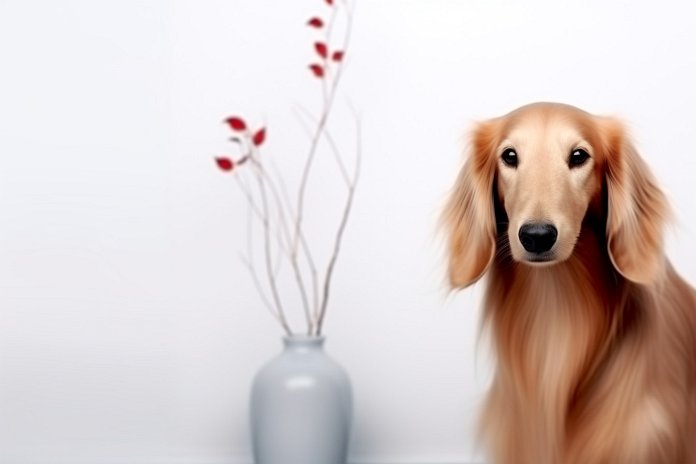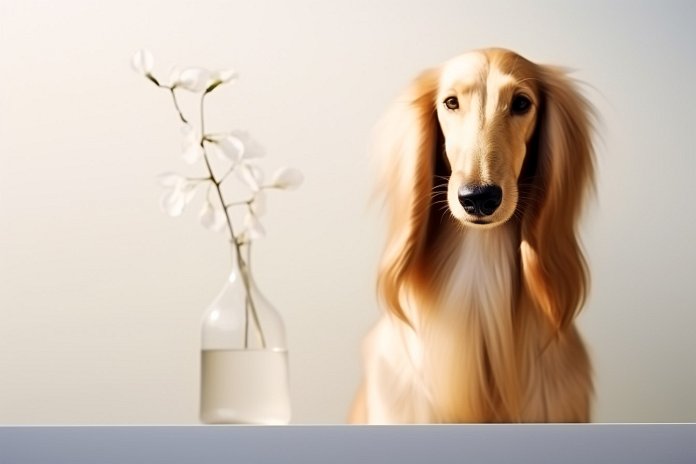
The Afghan Retriever is a large breed with floppy ears, a long flowing coat, and a lean yet powerful body. It bears a striking resemblance to a smaller version of the Golden Retriever. Both breeds are commonly used for hunting due to their exceptional skills. These dogs were bred to be active and athletic enough for hunting, while also being friendly and calm enough to make great companions at home.
The Afghan Retriever is known for being clever, independent, and amusing. They generally get along well with children and other animals, although it’s important to supervise them around young children under the age of five. These dogs come in various colors including yellow, cream, gold, white, and chocolate.
Below, we look at Afghan Retriever dog breed, its history, personality, pros and cons of owning an Afghan Retriever, characteristics, and must-know facts. We will also examine how to care for this breed and a lot more. Prepare for a tail-wagging adventure into the world of Afghan Retrievers!
| Dog Breed | Afghan Retriever |
| Size | Large |
| Weight | 50-70 lbs (average) |
| Height | 23-26″ (average) |
| Location | United States |
| Ancestry | Afghan Hound, Golden Retriever |
| Date of Origin | Unknown |
| Group | Sporting |
| Life Expectancy | 12-14 years |
| Price | $1000 – $2000 |
| Family | Canidae |
| Scientific Name | Canis Lupus Familiaris |
📖 Breed History
The Afghan Retriever is a relatively new breed, so its specific history is not yet known. However, by examining the history of its parent breeds, we can get an idea of what characteristics to expect from this breed. The Afghan Hound, an ancient breed from Afghanistan, was traditionally found roaming the Afghan mountains. They were later brought down to towns and used for hunting rabbits and gazelles for food. In the 1920s, Afghan Hounds were introduced to the United States, but they were primarily owned by wealthy individuals. They gained popularity as show dogs but saw a decline in popularity during the 1950s. On the other hand, the Golden Retriever originated in England in the early 1800s. These dogs were known for their exceptional retrieving abilities and were also skilled in hunting, field trials, obedience, and serving as guide dogs for the blind. They arrived in the United States in 1900 and quickly became popular as both show dogs and pets. They are currently the 3rd most popular dog breed in the United States, while the Afghan Hound ranks 113th in popularity. Golden Retrievers have been highly valued for their intelligence and have been utilized as therapy dogs, guide dogs, service dogs for the blind and handicapped, and even in narcotics detection.

🐕 Afghan Retriever Appearance
The Afghan Retriever resembles an Afghan Hound less so than a small-boned Golden Retriever. However, the long legs and slim, well-muscled torso definitely resemble the Afghan Hound, as do the hairy ears and large muzzle. The Afghan Hound has tiny, intelligent-looking brown eyes. They have a muscular body, big paw pads, and a long neck. They may grow to be as tall as 27 inches and as heavy as 65 pounds. The Golden Retriever has a sturdy, stocky build, a big, blocky head, a square nose, and brown eyes that are about the size of saucers. The Afghan Retriever is anticipated to resemble both breeds in appearance but may have a preference for one or the other. Due to the mixing of two distinct parent breeds, it is hard to predict how a hybrid breed would look.
| 👀 Eye Color | Brown |
| 🐽 Nose Color | Black |
| 🐕 Coat Color | Black, Brown, Red, Cream, Fawn |
⚡ Fun Fact: Afghan Retriever dogs are a social breed. They enjoy being around people or other animals. This breed doesn’t tolerate being left alone.
🐶 Traits & Temperament of Afghan Retriever
The Golden Retriever is one of the family-friendly dog breeds available, which accounts for its popularity. Due to their heritage as caretakers or guide dogs, they can get along with almost any animal and be trusted with kids of any age. Afghan Hounds are more difficult to train than other breeds since they may be a little obstinate. However, because Afghan Retrievers are extremely intelligent, you should be able to educate them to perform whatever you want provided you stay with the training and enforce positive behavior. After all, the Golden Retriever portion of their ancestry gives them a desire to please and a capacity for compliance.
🤝 Are Afghan Retrievers Friendly or Aggressive?
The Afghan Retriever dogs are known to get along well with other pets, making them a suitable choice for households with multiple animals. They are also friendly towards strangers and enjoy the company of children, making them an excellent choice for families with kids. While they are generally friendly towards cats, their level of friendliness may vary. Afghan Retrievers are also dog-friendly, making them a good option for those looking to have multiple dogs or participate in dog meetups. Additionally, they are considered one of the top breeds for elderly individuals, as they can provide companionship and support to older people.
This breed is known for being:
- Aloof
- Dignified
- Independent
- Clownish
- Happy
- Intelligent
- Confident
- Friendly
- Reliable
- Kind
- Trustworthy
🐩 Afghan Retriever Care & Maintenance
The Afghan Hound is hypoallergenic, however the Golden Retriever sheds moderately and seasonally, so you should anticipate some shedding throughout the summer. For optimal skin care and mat prevention, brush your Afghan Retriever at least twice a week. At this time, you should also wipe their ears and eyes and look for any swelling or redness. Many owners of the Afghan Hound and the Golden Retriever often take their dogs in for professional grooming, which is a good idea if you live in a warm area. If not, you can frequently clip the nails and clean your dog with a light shampoo as needed.
The Afghan Retriever dogs have a moderate shedding tendency, which is a normal part of their hair growth cycle. Brushing their fur regularly can help minimize the amount of hair that is shed. The shedding pattern can also vary depending on the dog’s overall health and the type of breed they belong to. In terms of bathing, it is recommended to give Afghan Retrievers a bath every 3-4 weeks.
🍖 Food: We recommend 3 cups daily, costing you about $1.50 – $1.90 daily, or roughly $39.00 – $52.00 a month.
🐾 Exercise: Afghan Retriever dogs need a lot of exercises. Long walks should be on a daily schedule. If you live an active life, this breed can be a good choice for you.
This dog breed requires to be walked for roughly 12 miles per week, which equates to about 60 minutes of physical activity daily. This consistent moderate exercise regimen will help maintain their physical wellness and significantly contribute to their mental stimulation. Consciously setting aside this time for your furry friend can dramatically enhance their life quality, helping them stay energetic, healthy, and mentally alert.
Did you know: Afghan Retriever dogs are high-energy dogs. An active lifestyle makes them happy.
❤️🩹 Afghan Retriever Health & Issues
Some of the major concerns for Afghan Retriever Dog Breed can be:
- Entropion
- Elbow Dysplasia
- Retinal Dysplasia
- Hip Dysplasia
While minor concerns include:
- Cataracts
- Bloat
- Histiocytosis
🤧 Important: Is Afghan Retriever hypoallergenic? No.
✨ Bonus: Check out cool, creative, and funny names for Afghan Retriever.
⚡ Afghan Retriever Dog Breed Facts
What makes the Afghan Retriever a great choice for families with young children?
The Afghan Retriever is a great choice for families with young children because they are known to be good with kids. However, it is important to note that they should not be left alone with children under five years old.
Is the Afghan Retriever breed considered a suitable breed for apartment living?
The Afghan Retriever breed is not considered suitable for apartment living. They are a large breed and require ample space to move and exercise.
How much exercise does a Afghan Retriever require compared to other breeds?
The Afghan Retriever requires a significant amount of exercise compared to other breeds. They are bred to be sporty and energetic, so daily exercise such as long walks and playtime is essential for their physical and mental well-being.
Is the Afghan Retriever breed known for being good with other pets?
The Afghan Retriever breed is known for being good with other pets. They have a friendly nature and can generally get along well with other animals in the household.
What are other low-maintenance dog breeds similar to the Afghan Retriever?
Some low-maintenance dog breeds similar to the Afghan Retriever include the Golden Retriever, Labrador Retriever, and Chesapeake Bay Retriever. These breeds share similar characteristics and are relatively easy to care for.
What are the common health issues that Afghan Retrievers are prone to?
Common health issues that Afghan Retrievers are prone to include hip dysplasia, elbow dysplasia, progressive retinal atrophy, and hypothyroidism. Regular vet check-ups and proper care can help mitigate these health concerns.
Are Afghan Retrievers known to be easy to train compared to other breeds?
Afghan Retrievers are generally considered to be easy to train compared to other breeds. They are smart dogs and have an eagerness to please, which makes training them relatively straightforward if positive discipline and consistency are applied.
Are Afghan Retrievers more prone to separation anxiety compared to other breeds?
Afghan Retrievers can be prone to separation anxiety, especially if not properly trained and socialized from a young age. It is important to gradually introduce them to being alone and provide them with mental stimulation and toys to keep them occupied.
Are there any dog breeds similar to the Afghan Retriever that are suitable for people with allergies?
Some dog breeds similar to the Afghan Retriever that are suitable for people with allergies include the Labradoodle, Goldendoodle, and Portuguese Water Dog. These breeds have hypoallergenic coats that produce fewer allergens.
What sizes of dogs similar to the Afghan Retriever are best for individuals or families with limited space?
For individuals or families with limited space, smaller-sized dogs similar to the Afghan Retriever, such as the Cocker Spaniel or English Springer Spaniel, can be a better fit. These breeds are energetic but can adapt well to smaller living spaces.
Is the Afghan Retriever breed known to be good with children with special needs?
The Afghan Retriever breed is generally known to be good with children, including those with special needs. However, as with any dog, proper supervision and training are essential to ensure a safe and harmonious interaction.
How does the grooming and shedding needs of the Afghan Retriever?
The grooming needs of the Afghan Retriever are high compared to many other breeds. Their long flowing coat requires regular brushing to prevent matting and regular visits to a professional groomer for trimming. They also shed moderately, so regular vacuuming is necessary to keep the house clean.
We use reliable and publicly available data and resources such as AKC and American Canine Registry to ensure that Afghan Retriever dog breed information is accurate and up to date. If you spot an error, please don’t hesitate to bring it to our attention.